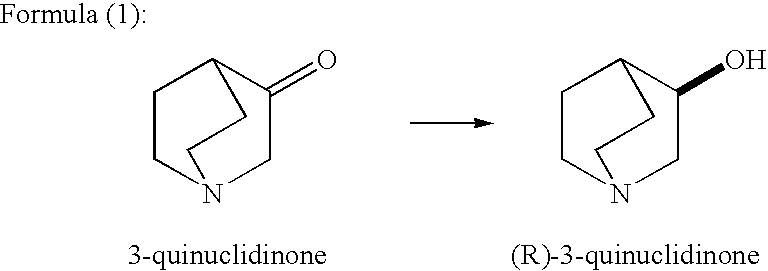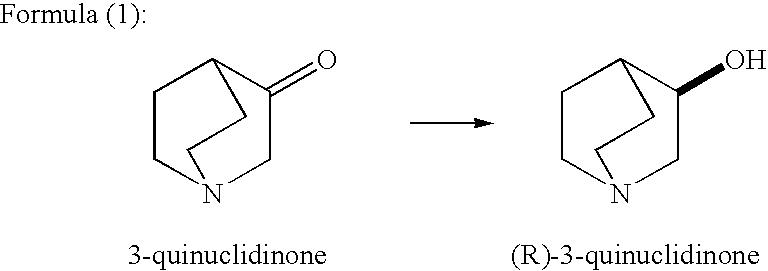Methods for producing optically active alcohols
a technology production methods, which is applied in the field of optically active alcohol production methods, can solve the problems of low optical purity of products obtained by these production methods, complicated synthesis steps of production methods, and low optical purity of products, and achieve high optical purity and efficient production of optically active alcohols
- Summary
- Abstract
- Description
- Claims
- Application Information
AI Technical Summary
Benefits of technology
Problems solved by technology
Method used
Image
Examples
example 1
Isolation of Datura stramonium Tropinone Reductase-I Gene
[0215] pETTR1 containing the gene encoding tropinone reductase-I from Datura stramonium was isolated according to the method as described in a literature (Proc. Natl. Acad. Sci. U.S.A., 95, 4876-4881 (1998)). In order to newly construct a plasmid, the primers DSR-ATG1 (SEQ ID NO: 5) and DSR-TAA1 (SEQ ID NO: 6) were synthesized based on the 5′-end and 3′-end sequences of the structural gene. Using pETTR1 as a template, a specific DNA was amplified by PCR (30 cycles of denaturation at 95° C. for 30 seconds, annealing at 50° C. for 1 minute, and extension at 75° C. for 3 minutes and 15 seconds).
SEQ ID NO: 5DSR-ATG1 / ATACCATGGAAGAATCAAAAGTG:SEQ ID NO: 6DSR-TAA1 / TGGTCTAGATTAAAACCCACCATTAGCTGTG:
example 2
Construction of Plasmid pSG-DSR1 for Co-Expression of Datura stramonium-Derived Tropinone Reductase-I and Bacillus subtilis-Derived Glucose Dehydrogenase Genes
[0216] The plasmid pSE-BSG1 (JP-A 2000-189170) containing the glucose dehydrogenase gene derived from Bacillus subtilis was double-digested with the restriction enzymes NcoI and XbaI, and thus a DNA fragment containing the glucose dehydrogenase gene derived from Bacillus subtilis was prepared. The DNA fragment was ligated, by using T4 DNA ligase, to a DNA fragment containing the tropinone reductase-I gene derived from Datura stramonium that had been obtained by digesting the DNA fragment prepared in Example 1 with the same enzymes. The plasmid pSG-DSR1 (FERM BP-8061), which allows co-expression of glucose dehydrogenase and tropinone reductase-I, was thus obtained.
example 3
Co-Expression of Datura stramonium-Derived Tropinone Reductase-I and Bacillus subtilis-Derived Glucose Dehydrogenase
[0217]E. coli HB101 strain transformed with pSG-DSR1 (E. coli HB101 (pSG-DSR1)) was cultured overnight in LB medium containing 50 mg / L ampicillin. 0.1 mM IPTG was added to the culture to induce the expression of genes. Then, the bacterial cells were further cultured for 4 hours. After harvesting, the bacterial cells were crushed in a closed chamber-type sonicator UCD-200TM (Cosmo Bio). The supernatant obtained by centrifugation was used as a cell-free extract.
PUM
| Property | Measurement | Unit |
|---|---|---|
| optical purity | aaaaa | aaaaa |
| optical purity | aaaaa | aaaaa |
| pH | aaaaa | aaaaa |
Abstract
Description
Claims
Application Information
 Login to View More
Login to View More - R&D
- Intellectual Property
- Life Sciences
- Materials
- Tech Scout
- Unparalleled Data Quality
- Higher Quality Content
- 60% Fewer Hallucinations
Browse by: Latest US Patents, China's latest patents, Technical Efficacy Thesaurus, Application Domain, Technology Topic, Popular Technical Reports.
© 2025 PatSnap. All rights reserved.Legal|Privacy policy|Modern Slavery Act Transparency Statement|Sitemap|About US| Contact US: help@patsnap.com


